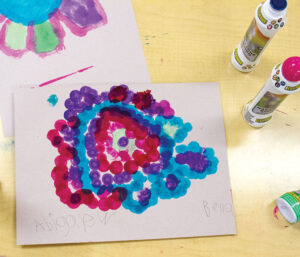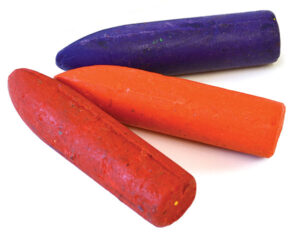Fine motor development
Toddlers make marks on paper with paintbrushes dipped in water.



Be Prepared: Place colored construction paper on a low table for two to four toddlers. Pour about a half cup of water into each cup. Gather supplies for wiping up spills.
[Invite two to four toddlers to the table for painting with water. Help each toddler get a craft apron or smock in place. Sit or kneel facing the toddlers to enhance communication. Give each toddler a small paintbrush.]
We are going to paint with water! Painting is fun. This is a paintbrush. We put our paintbrush in our cup of water. Then we make marks on our paper with the water.
[Demonstrate and describe how to gently dip the paintbrush in water and use it to paint a line on the paper.]
The water on my paintbrush changes the paper. I made a line on my paper. We can make marks on our papers with water on a paintbrush.
[Invite toddlers to try “painting” with water. Sit or kneel next to the table. Describe the marks toddlers paint on the paper. Examples: “You made a long line with your paintbrush and water.” “Leon is making marks on the paper by dripping water from his brush.”
Point out that we use our hands to paint. We hold the paintbrush with our fingers. We move our hand to make lines and other marks on our paper.
Acknowledge and expand on toddlers’ utterances.]
We will not see our marks when the water on our paper dries. We can look at our papers later today to see what happens.
We made marks on our paper with water we put on a paintbrush. We had fun putting lines and other marks on our paper. We used our fingers and hands to hold and move our paintbrush.
Painting with water supports creative interests with the unique feature that marks on a paper evaporate. Some toddlers may be fascinated by watching their picture dry and disappear. Be sure to provide an opportunity for toddlers to look at their paper later in the day or the next day. Explain that our picture goes away when the water dries. Use an excited manner to explain what happens so toddlers view the disappearance as interesting rather than a loss. Example: “Look, Emily! Your lines are drying, so it is hard to see them.”
Some toddlers may want to take the paper home. You may wish to offer an explanation of the activity to family members. Example of a note to post in your room: “Today we painted on paper with water. We looked at how our lines and marks on the paper went away when the water dried.”
Extra support
Enrichment
Fine motor development
Toddlers make marks on paper with dot markers.



Be Prepared: Rainbow dot markers are suggested. They are similar to Bingo markers. Put the lids out of reach. Make sure each marker is working properly. New dot markers sometimes need to be turned upside down or used by an adult to get the paint flowing. Standing at a low table typically works well for this activity.
 Invite several toddlers to put color on paper with dot markers. Explain that we can put dots on our paper where we wish. Demonstrate how to push the dot marker onto the paper with our hand. Explain that you will help us share markers so different colors can be used.
Invite several toddlers to put color on paper with dot markers. Explain that we can put dots on our paper where we wish. Demonstrate how to push the dot marker onto the paper with our hand. Explain that you will help us share markers so different colors can be used.
Kneel or sit and talk with the toddlers as they work. Describe toddlers’ efforts. Examples: “You pushed for a long time. Now there is a big dot.” “I see lots of dots on your paper.”
Help toddlers exchange markers. Keep in mind that, at this age, toddlers have not developed skills for sharing on their own.
Print each toddler’s name on his/her paper. You may wish to display the work in your room. Rainbow dot pictures look nice displayed in a window.
Toddlers will be pleased to see the effect from pushing down on a paint-filled dot marker. Providing a good supply of dot markers enables toddlers to spend more time exploring the cause and effect of their actions and less time waiting for a desired marker currently in use by another toddler.
You may see toddlers using one or both hands to press the dot marker onto the paper. There is not a preferred method at this age. See the Extra Support scaffolding tip for a sequenced approach to helping a toddler who has difficulty making a dot. If after providing individualized assistance a toddler continues to have difficulty making a dot while standing at the table, move his/her paper to a lower surface, such as the floor or a cube chair, where he/ she can put more pressure on the dot marker.
At this age, toddlers are becoming aware of others, but do not consistently recognize that another child may want a dot marker that he/she is using. Use your classroom’s rules about sharing to help toddlers manage the dot markers. You also might suggest a toddler try an alternative to a desired color in use elsewhere. Flexibility is a useful self-regulation skill to begin developing early in life.
A toddler may attempt to gather all the dot markers next to his/her own paper while doing the activity. Offer a simple explanation of the need to share the markers. Example: “The dot markers are for all our friends to use. We need to keep the markers on the table where everyone can get a marker.”
If a toddler wants to carry the dot marker to another area, you may wish, give him/her a suitable item to carry in exchange for the marker. Example: “Dot markers stay at the table. You can carry this (name of toy) to the play area.” In general, toddlers are willing to give an item in exchange for another object. Without a trade or exchange, a toddler may react defensively.
Extra support
Enrichment
Fine motor development
Toddlers use crayons on easel paper.



 Attach paper to an easel and provide chubby crayons for toddlers to use in making marks on the easel paper, 1–2 toddlers at a time. Invite toddlers to make any types of marks on the paper. Leave the paper in place for the duration of the play period and provide a new piece of paper when space is limited for making marks. Toddlers will be mostly interested in the process of making marks and unconcerned about the products.
Attach paper to an easel and provide chubby crayons for toddlers to use in making marks on the easel paper, 1–2 toddlers at a time. Invite toddlers to make any types of marks on the paper. Leave the paper in place for the duration of the play period and provide a new piece of paper when space is limited for making marks. Toddlers will be mostly interested in the process of making marks and unconcerned about the products.
Talk with a toddler about his/her crayon marks. Offer comments about the shapes and on the intensity of the colors. Example: “You are making lots of marks on the paper!” Some toddlers may offer words to describe their marks, such as “I make truck.” Repeat the meaning back to the toddler. “You made a picture of a truck.” Avoid asking the child what he/she is drawing.
Using an artistic tool, such as a crayon, dot marker, or paintbrush, supports the coordination of fine motor skills that undergo rapid change during this period of development. Standing at an easel presents another way of making marks.
It is appropriate for toddlers to come and go from this activity throughout the play period. Toddlers are typically involved in gross motor activities and may spend short periods of time with the crayons.
Toddlers may create light marks with the crayons. If a toddler seems interested, provide verbal support and a demonstration of how pressing harder on a crayon produces a darker mark.
Extra support
Enrichment
Materials Needed: small- or medium-sized cardboard box, paper, chubby crayons, tape, dark‑colored paper, sidewalk chalk, Beautiful Oops by Barney Saltzberg, Mouse Paint by Ellen Stoll Walsh, The Artist Who Painted a Blue Horse by Eric Carle
Be Prepared: Cover a cardboard box with paper.
Place the paper-covered box near a low table where chubby crayons are located. Encourage toddlers to make crayon marks on the box. On another day, tape dark-colored paper on a low table and provide sidewalk chalk for the toddlers to make marks.
Display the suggested books in a prominent location. Sit on the floor and look at pictures in the books with one to two toddlers at a time.
Materials Needed: paint, sponge brushes, different-sized paintbrushes and/or large feathers, paint rollers, a paint tray or other flat tray, large paintbrushes, and water
Invite preschool-age children to join toddlers in painting (Option 1). Provide different types of tools, such as sponge brushes, different-sized paintbrushes, and/or large feathers. If possible, extend the activity to outdoors. Provide paint rollers, a paint tray or other flat tray, large paintbrushes, and water. Invite children to use larger tools to “paint” with water available items, such as a sidewalk, driveway, deck, or fence.